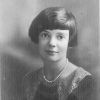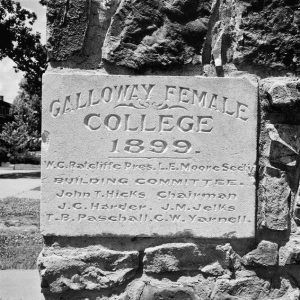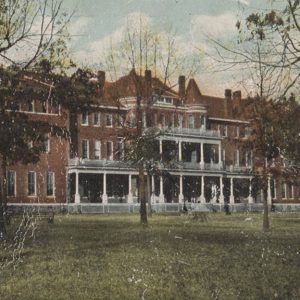calsfoundation@cals.org
Galloway Women's College
aka: Galloway Female College
Galloway Women’s College in Searcy (White County) was one of the longest survivors from among the schools established in the 1800s by the Methodist Episcopal Church, South, in Arkansas. Dedicated in honor of Bishop Charles Betts Galloway on April 18, 1889, the school endured until its final merger with Hendrix College in Conway (Faulkner County) in 1933.
Methodist Church leaders realized by the latter part of the nineteenth century that their resources could not support the numerous small schools they had established around the state and decided to concentrate efforts on fewer institutions to provide better facilities and sounder education. Under the leadership of Bishop Galloway, leaders decided to focus on one institution primarily for men and Galloway Female College, as it was then known, as the counterpart for women. Searcy won bidding rights for location of the women’s school through pledges of $25,000.
Galloway Female College had problems from the beginning. Its first president, Robert W. Erwin, died less than two months before the scheduled beginning of classes. The national Panic of 1893 led to a failure in 1896 of a planned bond issue to finance buildings and equipment. A fire in 1898 completely destroyed the school’s impressive four-story building. In spite of handicaps, the school grew rapidly. Within five years, students, most of whom were from Arkansas, had to be turned away for lack of housing. In 1925–26, enrollment reached a high of 269.
In common with most other schools of the day, Galloway’s curriculum was designed to cover a wide range of educational attainments from primary to secondary levels. Traditional curriculum included homemaking and secretarial training. The school was particularly strong in music, art, and speech. At the end of the 1800s, more occupational and professional courses were offered. By 1908, kindergarten and primary levels were discontinued. Frequent well-attended concerts, recitals, and exhibitions of student and faculty work sponsored through highly competitive literary societies bolstered social life.
During the first decade of the twentieth century, with money scarce, Methodists proposed unifying Hendrix College and Henderson College (later Henderson-Brown College), a co-educational college in Arkadelphia (Clark County), with Galloway under one administration, making Henderson and Galloway two-year schools. The plan, vigorously fought by both Henderson and Galloway, was instituted a few years later. Galloway operated under a deficit for several years, and enrollment fell to seventy-five in 1932–33. The decline sounded the death knell for Galloway. The school was closed following its final commencement in June 1933, at which time nineteen diplomas were awarded, and the operations were merged with Hendrix College. A year later, the property was sold to Harding College (now Harding University) for a fraction of its estimated value.
Four presidents led the college after its opening: Sidney H. Babcock (1889–1892), John Hixon Dye (1892–1897), Charles Conway Godden (1897–1907), and Dr. John Milton Williams (1907–1933). During Williams’s tenure, the college became known as Galloway Women’s College. Galloway alumni, known for their fierce loyalty to the school, held reunions in Searcy or Little Rock (Pulaski County) for forty-eight years until their last reunion in 1981, which took place at Galloway Hall women’s dormitory on the campus of Hendrix College.
For additional information:
Britton, Nancy. Two Centuries of Methodism in Arkansas, 1800–2000. Little Rock: August House, 2000.
Galloway College Collection. Butler Center for Arkansas Studies. Central Arkansas Library System, Little Rock, Arkansas. Finding aid online at https://cdm15728.contentdm.oclc.org/digital/collection/findingaids/id/3653/rec/1 (accessed February 23, 2024).
Lester, James E., Jr. Hendrix College: A Centennial History. Conway, AR: Hendrix College Centennial Committee, 1964.
Meriwether, Robert W. “Galloway College: The Early Years, 1889–1907.” Arkansas Historical Quarterly 40 (Winter 1981): 291–329.
Katherine Stanick
Little Rock, Arkansas
 Barton, Dorothy Yarnell
Barton, Dorothy Yarnell Galloway Female College Marker
Galloway Female College Marker  Galloway Women's College
Galloway Women's College 



Going through family books and came across Elements of Geology from Galloway College 1910. My great-great-aunt Esther Thomas’s book.
In 2011, my daughter, Grace Corinne Ferguson, received the Dr. John Milton Williams Scholarship at Vanderbilt University. Because of her high grade point average, she had received an email from the Vandy Scholarship Dept. stating that a person may qualify for the Williams Scholarship if he or she is a descendant of a “Galloway Girl,” one who attended Galloway Women’s College in Searcy, Arkansas. Jokingly, she forwarded it to me, saying, “Mom, we are related to everyone in Arkansas’can I apply for this?” I utilized the information from this website to make the connection. My grandmother, Corinne Bevill Frantz Birkhead, graduated from Henderson University (Arkadelphia, AR) in 1924 and then from Peabody (now Vanderbilt) Graduate School in 1928 with her master’s degree. Grace received the scholarship, valued at about $100,000, because Galloway and Henderson were joined for that two-year period 1931-1933 as one administrative university. Later, we found out that my grandmother’s first cousin, Fern Bevill Rogers (married to and murdered by Dr. Porter Rogers of Searcy), graduated from Galloway. In a conversation with Fern’s daughter, Ann Rogers Whetsell, she remembered Dr. John Williams coming to her home for dinner when she was a child in Searcy. Her mother, Fern, was an active alumna Galloway Girl until her death. Upon Dr. Williams’s death in 1950, the alumni created this scholarship in his honor, having to place it at his alma mater (Vanderbilt) since Galloway no longer existed. Ann and I surmise that her mother was instrumental in this donation. (Coincidentally, Ann Whetsell lives in Nashville. Her husband, Dr. William Whetsell, just retired from practicing and teaching for twenty-five years at Vanderbilt Medical School.) Small world!
My maternal grandmother, Jessie Veronica Finley Flippen, was born (1892) and reared in Searcy. She attended Galloway Female College, according to my mother, the late Nel Margaret Flippen Binz.
Our mother spoke often about how her mother came from a family that encouraged education. She had three brothers, all of whom had professional careers; she also had two sisters, one who worked for Sears in Memphis and the other who lived in Tyronza.
I am exploring local records in Searcy to learn who my grandmother’s parents were. Our mother said the Finleys grew up in the same neighborhood with the Yarnell family, founder of the widely known ice cream company.